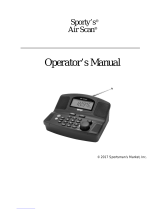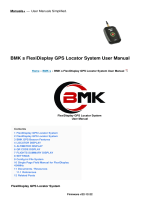
Garmin G1000 Pilot’s Guide for the Beechcraft 58/G58
190-00629-01 Rev. Bviii
TABLE OF CONTENTS
6.6 L-3 Skywatch Traffic Advisory System (TAS) ..... 343
TAS Symbology ......................................................... 343
Operation ................................................................ 344
Altitude Display ........................................................ 346
Traffic Map Page Display Range ................................. 347
TAS Alerts ................................................................ 348
System Status ........................................................... 349
SECTION 7 AUTOMATIC FLIGHT CONTROL SYSTEM
7.1 AFCS Overview .................................................... 351
Additional AFCS Controls .......................................... 353
7.2 Flight Director Operation ................................... 354
Activating the Flight Director ..................................... 354
AFCS Status Box ....................................................... 355
Flight Director Modes ................................................ 356
Command Bars ......................................................... 356
7.3 Vertical Modes ..................................................... 357
Pitch Hold Mode (PIT) ............................................... 358
Selected Altitude Capture Mode (ALTS) ....................... 359
Altitude Hold Mode (ALT) .......................................... 360
Vertical Speed Mode (VS) .......................................... 361
Flight Level Change Mode (FLC) ................................. 362
Vertical Navigation Modes (VPTH, ALTV) ..................... 364
Glidepath Mode (GP) (waas only) ............................... 369
Glideslope Mode (GS) ............................................... 371
Go Around Mode (GA) .............................................. 372
7.4 Lateral Modes ...................................................... 373
Roll Hold Mode (ROL) ............................................... 374
Navigation Modes (GPS, VOR, LOC, bc) ....................... 376
Approach Modes (GPS, VAPP, LOC) ............................. 378
7.5 Autopilot and Yaw Damper Operation ............. 380
Flight Control ........................................................... 380
Engagement ............................................................. 381
Control Wheel Steering ............................................. 381
Disengagement ........................................................ 382
7.6 Example Flight Plan ............................................ 383
Departure ................................................................ 384
Intercepting a VOR Radial .......................................... 386
Flying a Flight Plan/GPS Course ................................. 387
Descent ................................................................... 388
Approach ................................................................. 392
Go Around/Missed Approach ..................................... 394
7.7 AFCS Annunciations and Alerts .........................396
AFCS Status Alerts .................................................... 396
Overspeed Protection ................................................ 397
SECTION 8 ADDITIONAL FEATURES
8.1 SafeTaxi ................................................................ 399
SafeTaxi Cycle Number and Revision .......................... 402
8.2 ChartView ............................................................. 405
ChartView Softkeys ................................................... 405
Terminal Procedures Charts ....................................... 406
Chart Options ........................................................... 416
Day/Night View ........................................................ 422
ChartView Cycle Number and Expiration Date ............. 424
8.3 FliteCharts ............................................................ 428
FliteCharts Softkeys .................................................. 428
Terminal Procedures Charts ....................................... 429
Chart Options ........................................................... 437
Day/Night View ........................................................ 441
FliteCharts Cycle Number and Expiration Date ............. 443
8.4 XM Radio Entertainment (Optional) ................. 447
Activating XM Satellite Radio Services ........................ 447
Using XM Radio ....................................................... 449
8.5 Scheduler .............................................................. 453
8.6 Abnormal Operation ........................................... 455
APPENDICES
Annunciations and Alerts ............................................. 457
Alert Level Definitions ............................................... 459
Aircraft Alerts ........................................................... 459
G1000 System Annunciations .................................... 461
G1000 System Message Advisories ............................. 464
AFCS Alerts .............................................................. 475
TAWS ALERTS ........................................................... 476
SD Card Use ................................................................... 479
Jeppesen Databases .................................................. 479
Garmin Databases .................................................... 480
Glossary .......................................................................... 483
Frequently Asked Questions ........................................ 491
Map Symbols ................................................................. 497
INDEX
Index ................................................................................I-1






















